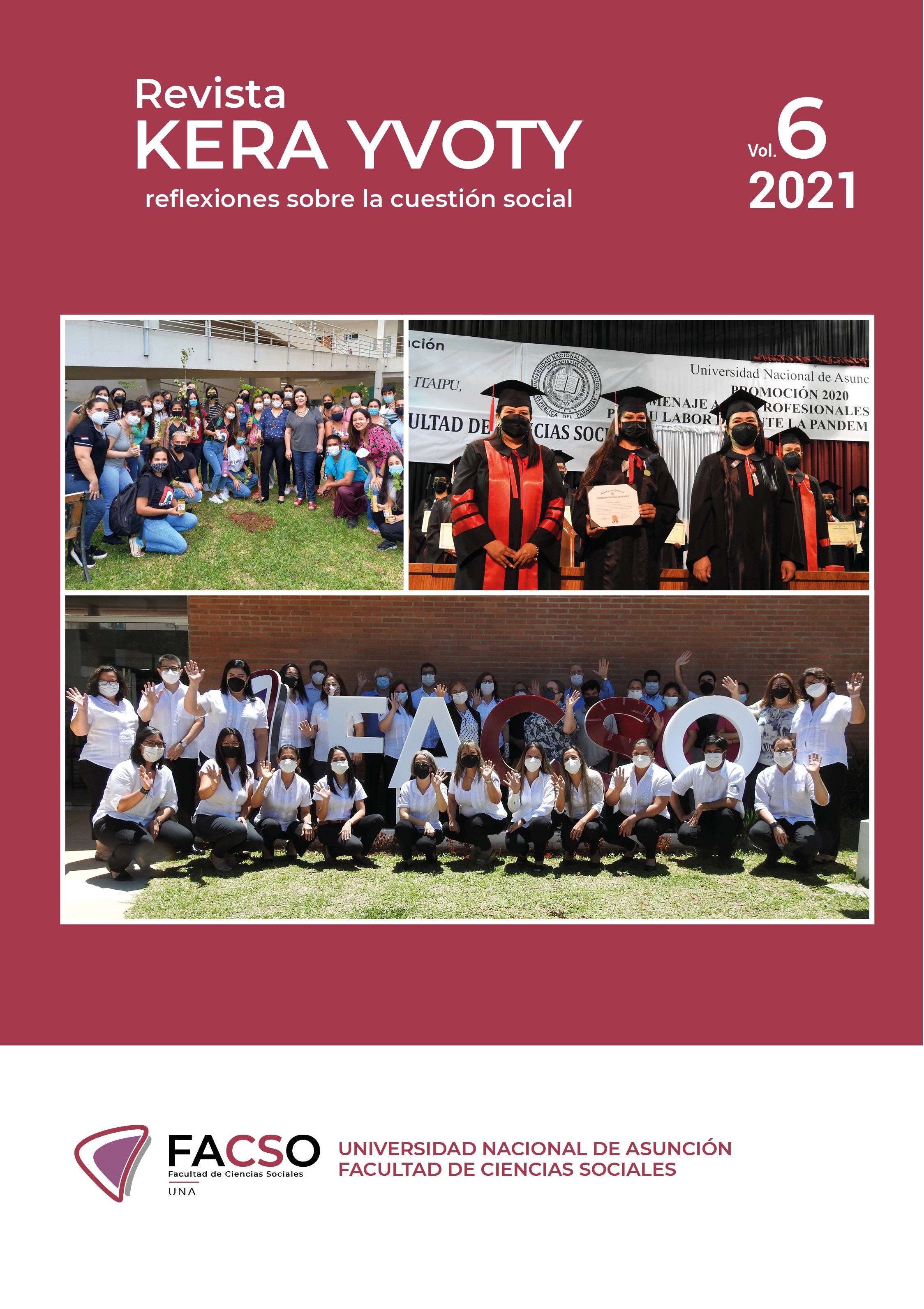Abstract
The work analyzed the possibility of generating income from of the economic valuation of breast milk in Paraguay. The challenges for this vision are located from morality and ethics, taking into account because most of the existing Milk Banks function as women donation. However, the need to value can be resignified by three visions: unpaid work of women, child nutrition and problems with the supply of well. The objective was to identify the importance of the Milk Bank for the income of domestic economies in Paraguay in the year 2020. The work was qualitative, used the documentary-bibliography, supported by semi-structured interviews with staff of the Maternal and Child Hospital of San Pablo de Asunción. analyzing the situation of the Breast Milk Bank at a global and regional level it was observed that in almost all countries breast milk is donated for the women. However, in some countries like Bulgaria, women are paid for it, because there are certain requirements to be met for a woman to donate, which which carries costs. Therefore, the document raised the possibility of Generate a subsidy for the donation of human milk through savings and credit cooperatives, taking into account the commitment with the equity of It is concluded that the generation of income from milk is possible, supported by its transcendental function for the beginnings of human life.
References
Achinelli, M., & Bernal, G. (2014). Planificando la prestación económica durante el cese laboral por maternidad. Revista Población y Desarrollo. 20(39). https://revistascientificas.una.py/index.php/RE/article/view/1476/1439
Aedo, C. (2007). Evaluación económica de la prolongación del postnatal. Universidad Alberto Hurtado. Rev Chil Pediatr. 78 (Supl 1): 10-50. http://www.scielo.cl/pdf/rcp/v78s1/art03.pdf
Aguayo, V., Ross, J., Saunero, R., Tórrez, A. Y Johnston, R. (2001). Valor monetario de la leche materna en Bolivia. Rev Panam Salud Pública/Pan Am, 10(4), 249-256
Bejarano, J., Ramos Riveras, J., Castro Prieto, A., & Rueda Guevara, Y. (2015). Hacia la formulación de una política pública en Bancos de Leche humana en Colombia. Revista Gastrohnup. 17(2). https://catalog.ihsn.org/citations/?keywords=Alejandro%20Rueda&field=authors
Castillo Belén, J., Rams Veranes, A., Castillo Belén, A., Rizo Rodríguez, R. & Cádiz Lahens, A. (2009). Lactancia materna e inmunidad: Impacto social. MEDISAN, 13(4) http://scielo.sld.cu/scielo.php?Script=sci_arttext&pid=S1029-30192009000400013&lng=es&tlng=es
Chavarria, V. E., & Dueñas, G. (2018). Estructura de costo del Banco de Leche humana del Hospital Lagomaggiore. Biblioteca Digital Uncuyo. https://bdigital.uncu.edu.ar/13986
Confederación Paraguaya de Cooperativistas Limitada, (CONPACOOP). (2012). Censo Nacional Cooperativo. Confederación Paraguaya de Cooperativistas Limitada. Asunción. http://conpacoop.coop.py/web/wp-content/uploads/bsk-pdf-manager/Censo_Nacional_Cooperativo_2012_31.pdf
Da Silva, R., Campos, C., Montoya, R. y Schmidt, J. (2015). Experiencias de donación de leche humana en Andalucía-España: un estudio cualitativo. Enfermería Global. 14(1). https://www.researchgate.net/publication/272642444_Experiencias_de_donacion_de_leche_humana_en_Andalucia-Espana_un_estudio_cualitativo
Echauri, C., & Serafini, V. (2011). Igualdad entre hombres y mujeres en Paraguay: la necesaria conciliación entre familia y trabajo. Organización Internacional del Trabajo. http://www.decidamos.org.py/mujeryeconomia/wp-content/uploads/2018/05/Echauri-Serafini-Igualdad-Conciliaci%C3%B3n-Familia-Trabajo.pdf
Estevez, L. C., & Fleury Seidl, E. M. (2010). Donación de la leche materna y apoyo social: relato de mujeres donadoras. Revista Latinoamericana Enfermagem. 18(3). https://www.scielo.br/j/rlae/MPtLC6CGYnkgn6q3pG/?lang=es
European Milk Bank Association. (2021). EMBA. https://europeanmilkbanking.com/
Feferbaum, R., & Cícero, F. (2003). Nutrición del recién nacido.
Guerra de Almeida, Da Silva, Novak, & Sydronio, 2006
Herrera, M. (10 de agosto de 2021). Entrevista brindada en el Hospital Materno Infantil San Pablo.
Herrera, M., Berganza, E., Giménez, S., Cardozo, D., & Jiménez, V. (2013). Puesta en marcha del Primer Banco de Leche Humana en el Hospital Materno-Infantil San Pablo, Asunción, Paraguay. Pediatría (Asunción), 40(3), 253-260. http://scielo.iics.una.py/scielo.php?script=sci_arttext&pid=S1683-98032013000300008&lng=en&tlng=es
Lemus Lago, E. R., & Báez Martínez, J. M. (2011). Lactancia materna. Medicina General Integral. ECIMED. 112(3).
Ley N° 5508/2015, De promoción, protección de la maternidad y apoyo a la lactancia materna. https://www.bacn.gov.py/leyes-paraguayas/4428/promocion-proteccion-de-la-maternidad-y-apoyo-a-la-lactancia-materna
Machado, R., Campos Calderón, C., Montoya Juárez, R., & Schmidt Rio Valle, J. (2015). Experiencias de donación de leche humana en Andalucía-España: un estudio cualitativo. Enfermería Global: Granada, (37). https://scielo.isciii.es/scielo.php?script=sci_arttext&pid=S1695-61412015000100006
Ministerio de Salud y Protección Social. (2019). Lineamientos Técnicos para la Estrategia de Bancos de Leche Humana en Colombia. Actualisalud. https://actualisalud.com/wp-content/uploads/2019/03/Lineamientos-t%C3%A9cnicos-Banco-de-leche-humana.pdf
Organización Internacional del Comercio Justo. (2021). Principales definiciones. https://comerciojusto.org/que-es-el-comercio-justo-2/
Organización Mundial de la Salud, OMS. (2002). Estrategia para la Alimentación del Lactante y del Niño/a Pequeño. En 55a Asamblea Mundial de la Salud.
Organización Mundial de la Salud, OMS. (2007). Indicadores para evaluar las prácticas de alimentación del lactante y del niño/a pequeño. Washington, DC. EE.UU. http://whqlibdoc.who.int/publications/2009/9789243596662_spa.pdf
Organización Panamericana de la Salud (OPS) y Organización Mundial de la Salud, OMS. (2016). Lactancia materna en el siglo XXI. Organización Mundial de la Salud/Organización Panamericana de la Salud. https://www.paho.org/hq/dmdocuments/2016/LactanciaMaternaEnSigloXXI-April15.pdf
Organización Panamericana de la Salud, OPS. (2009). Iniciativa Hospital Amigo del Niño/a, revisada, actualizada y ampliada para la atención integral, Sección 4. Autoevaluación y Monitoreo del Hospital.
Reid, M. (1934). Economics of Household Production. John Wiley & Sons.
Rossel, C. (2013). Políticas para las familias en América Latina: Panorama de políticas de reducción de pobreza y conciliación entre trabajofamilia. http://www.un.org/esa/socdev/family/docs/FAMILYPOLICIESINLATINAMERICA.pdf
Schanler, R. (2001). The use of human milk for premature infants. Pediatr Clin North Am. 48(1):207-19.
Secretaría General Iberoamericana, SEGIB. (2016). Informes de 2017 en adelante disponibles en la Plataforma de Seguimiento de la Cooperación Iberoamericana. https://www.segib.org/programa/programa-iberoamericano-red-de-Bancos-de-leche-humana/
Secretaría General Iberoamericana, SEGIB. (2021). Proyecto adscrito Red de Bancos de Leche Humana. https://www.segib.org/programa/programa-iberoamericano-red-de-Bancos-de-leche-humana/
Serafini, V. (2008). La liberalización económica en Paraguay y su efecto sobre las mujeres. Consejo Latinoamericano de Ciencias Sociales (CLACSO). http://bvsde.org.ni/clacso/publicaciones.
Soto, M. (2007). Manual técnico y funciones Banco de Leche humana Hospital Nacional Pedro de Bethancourt.

This work is licensed under a Creative Commons Attribution 4.0 International License.
Copyright (c) 2021 Marcela Achinelli






